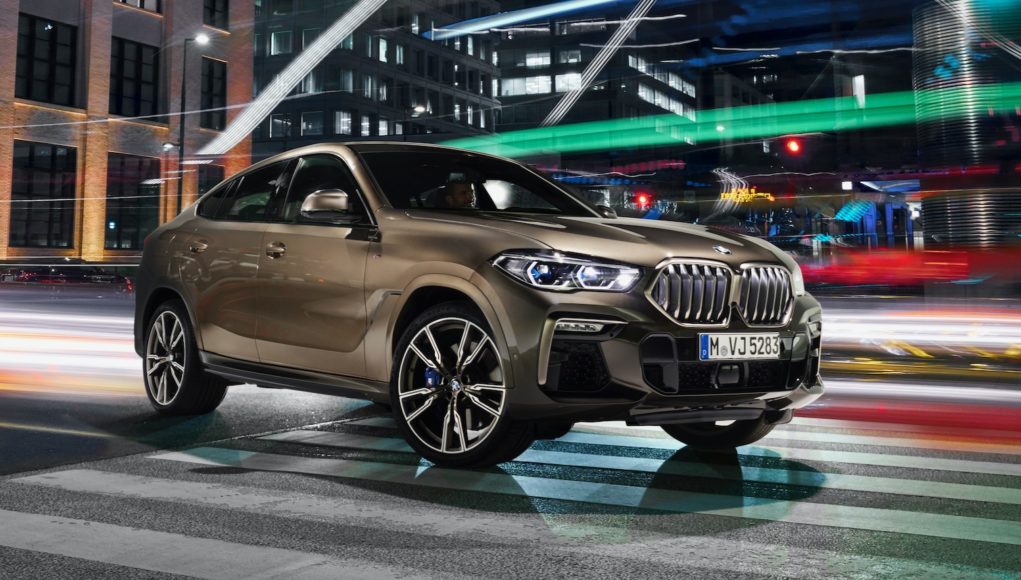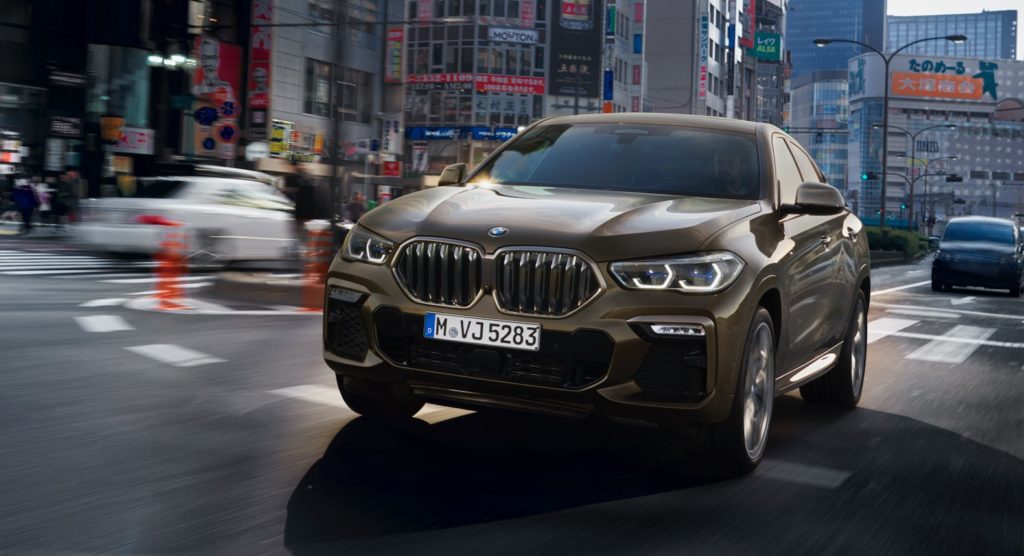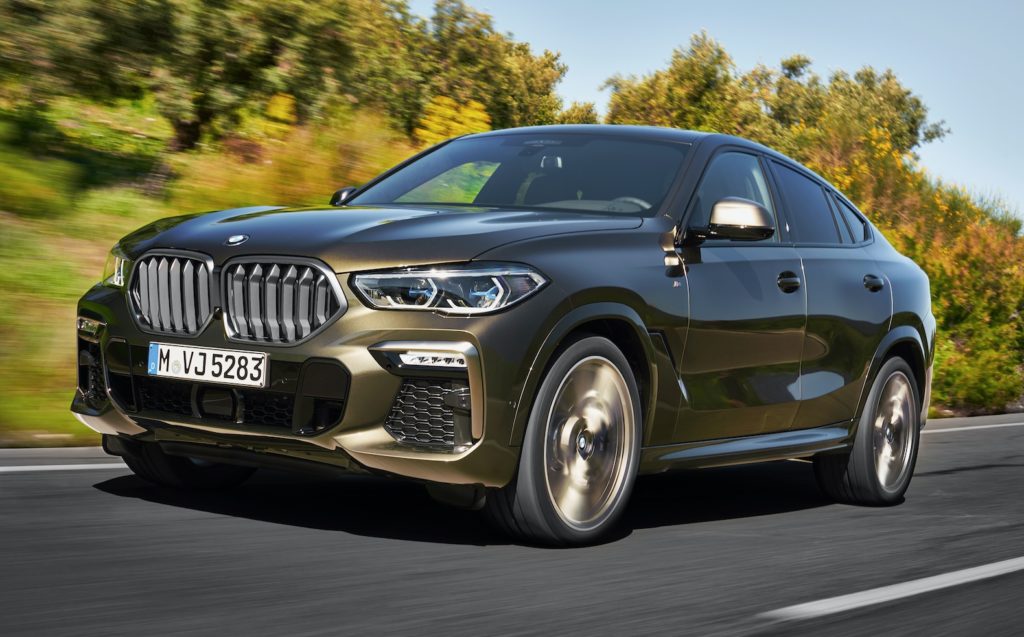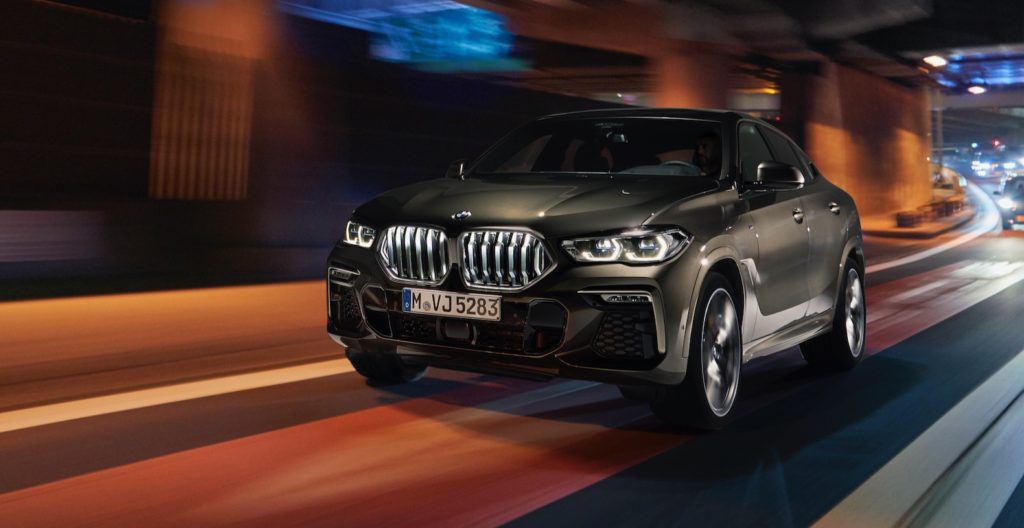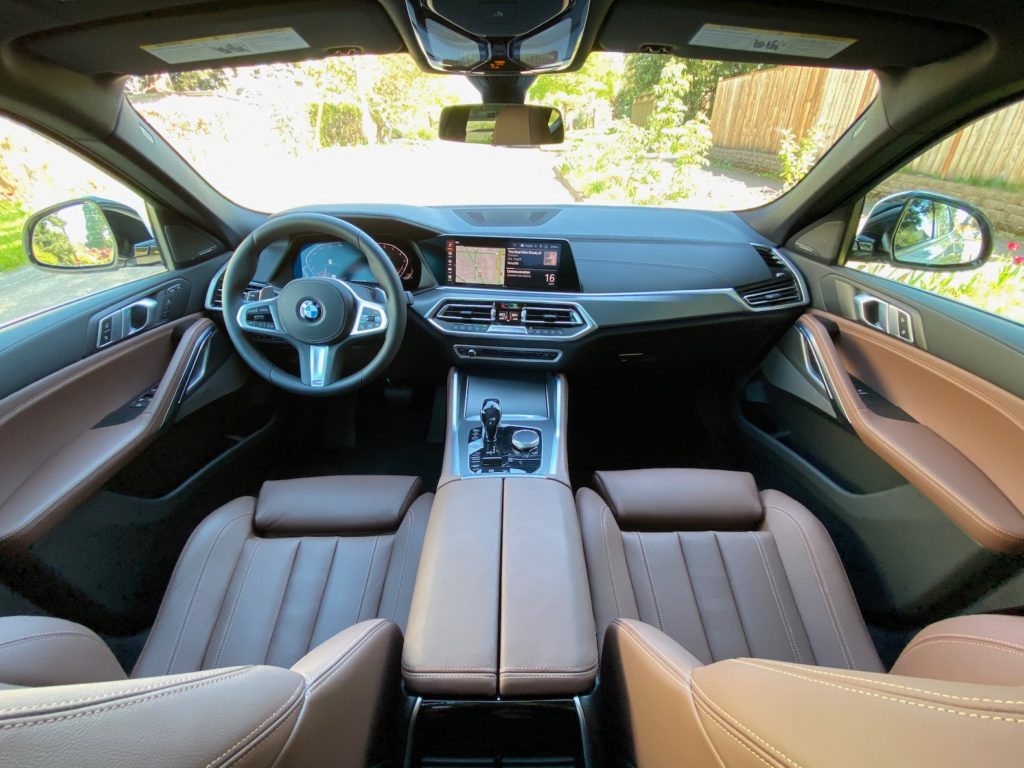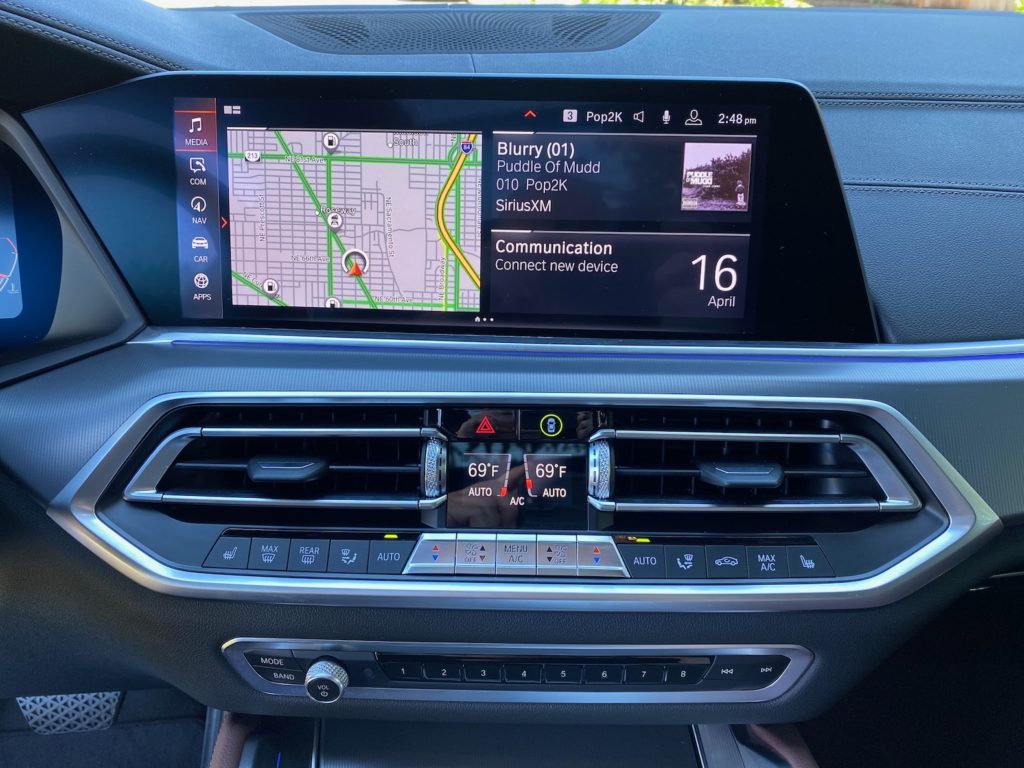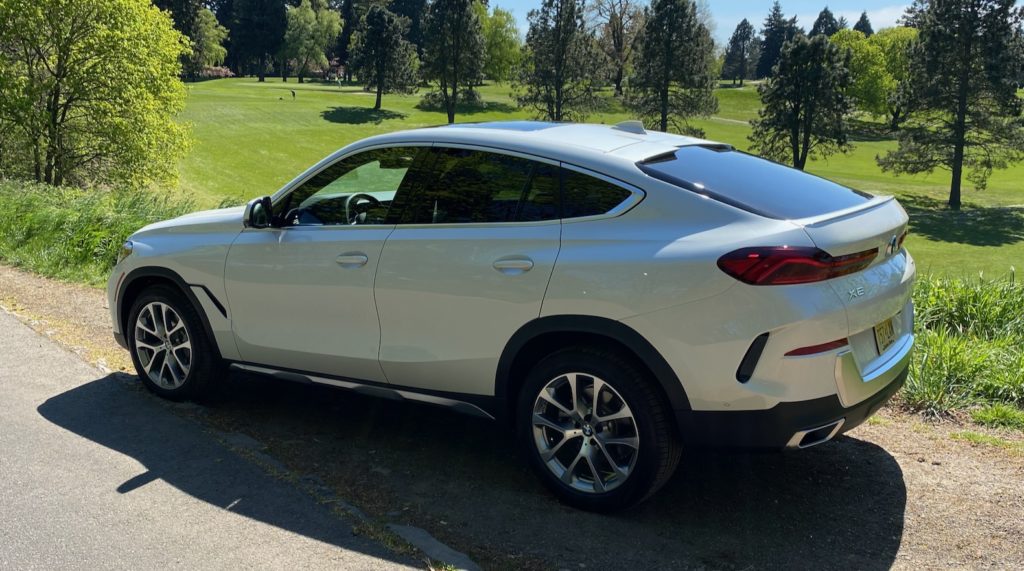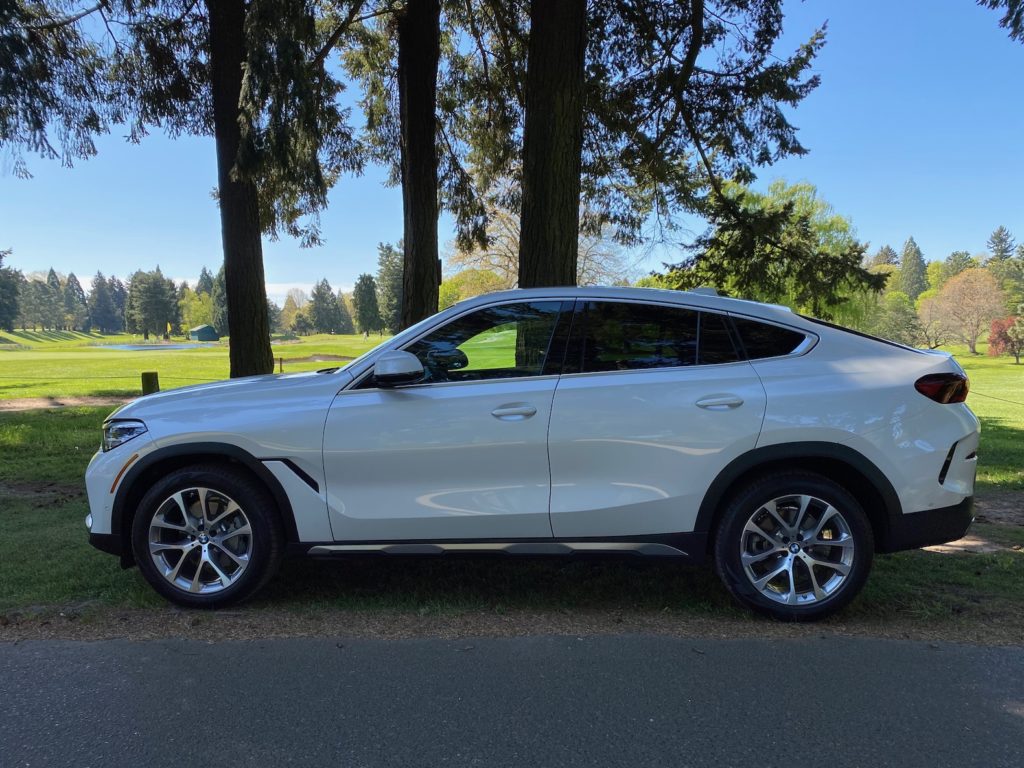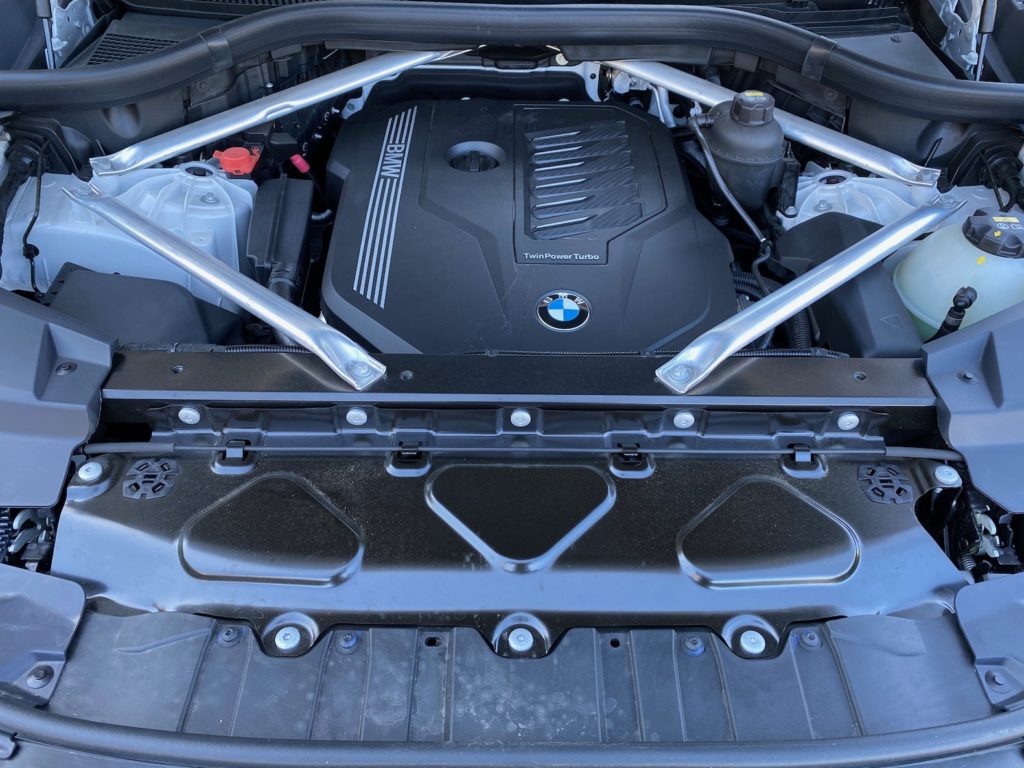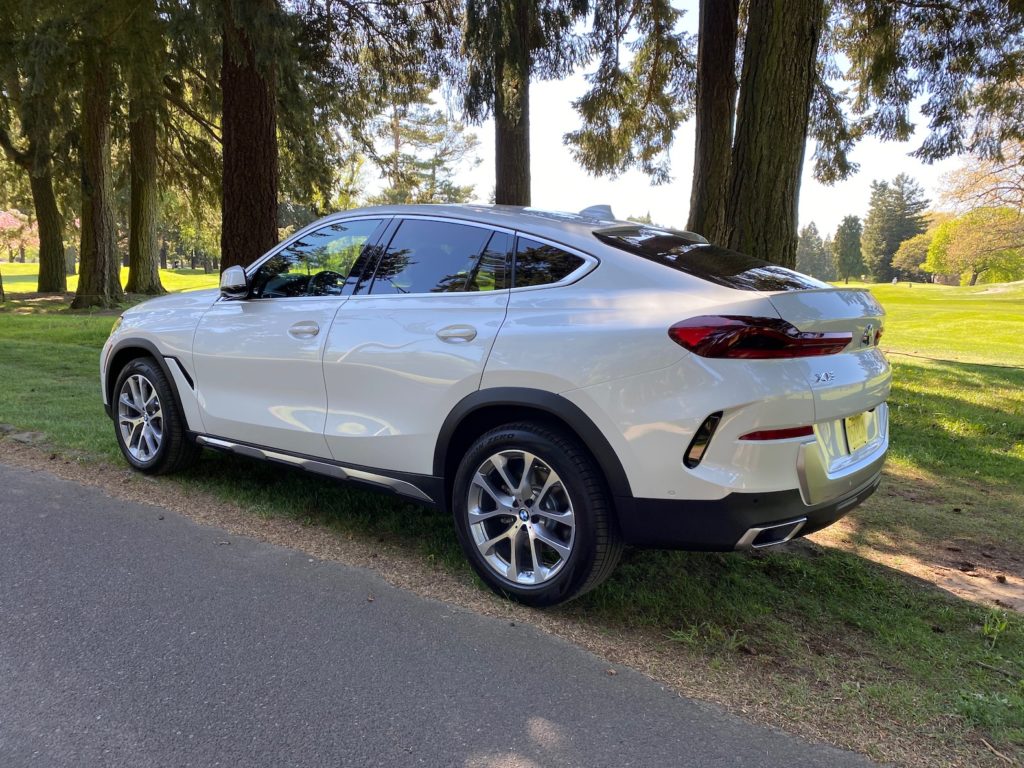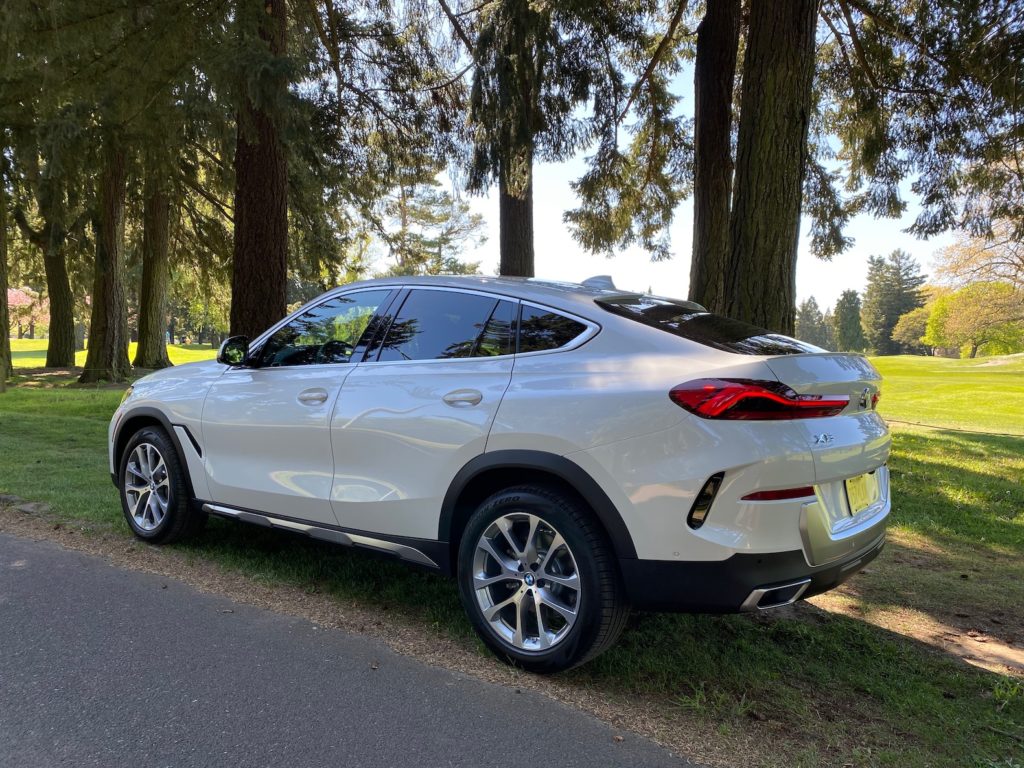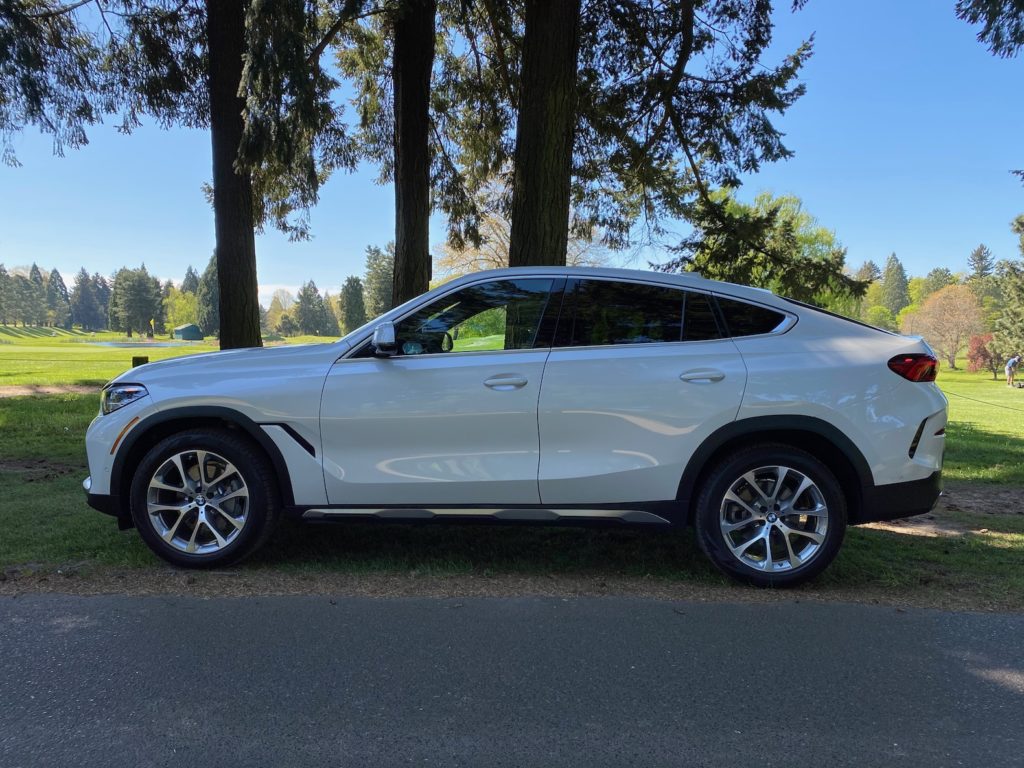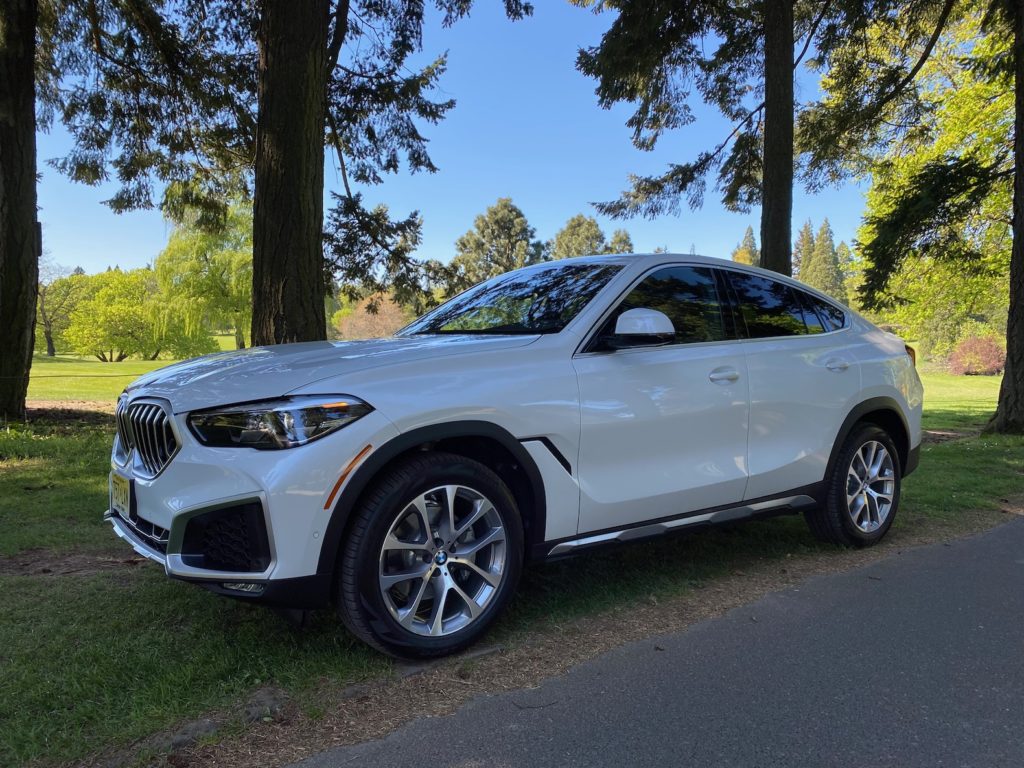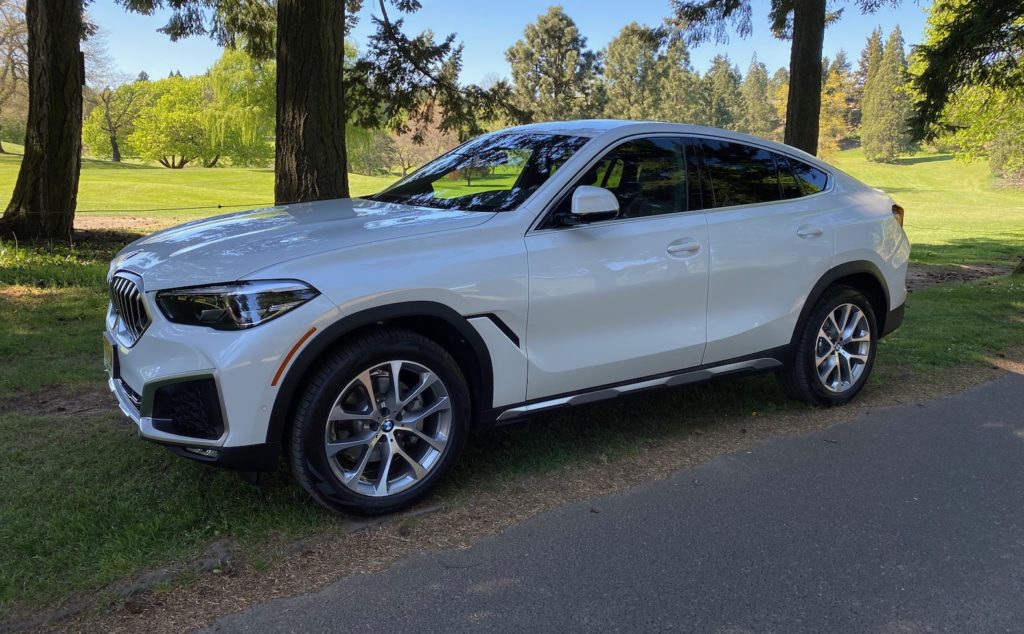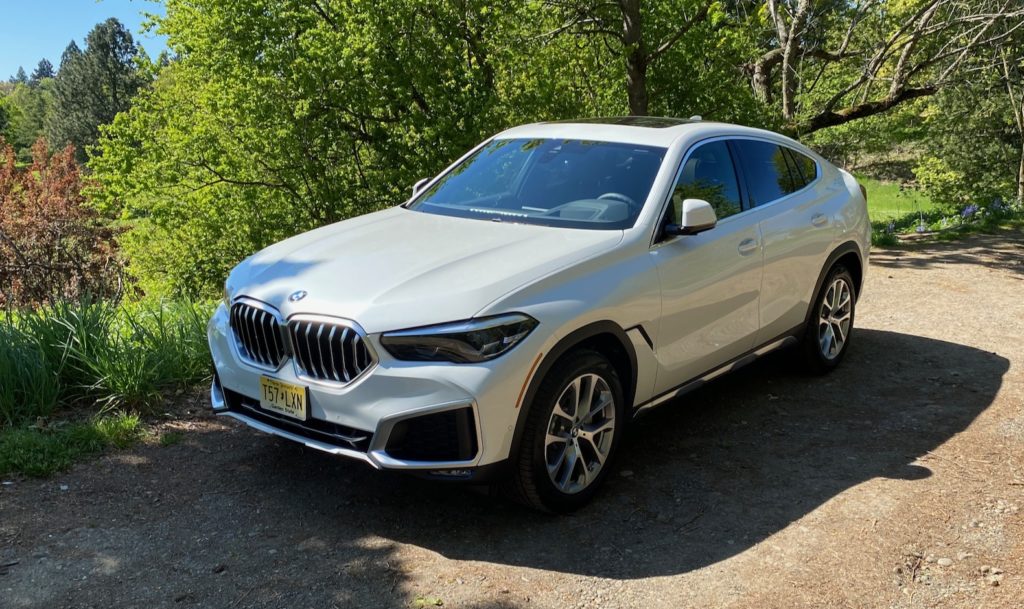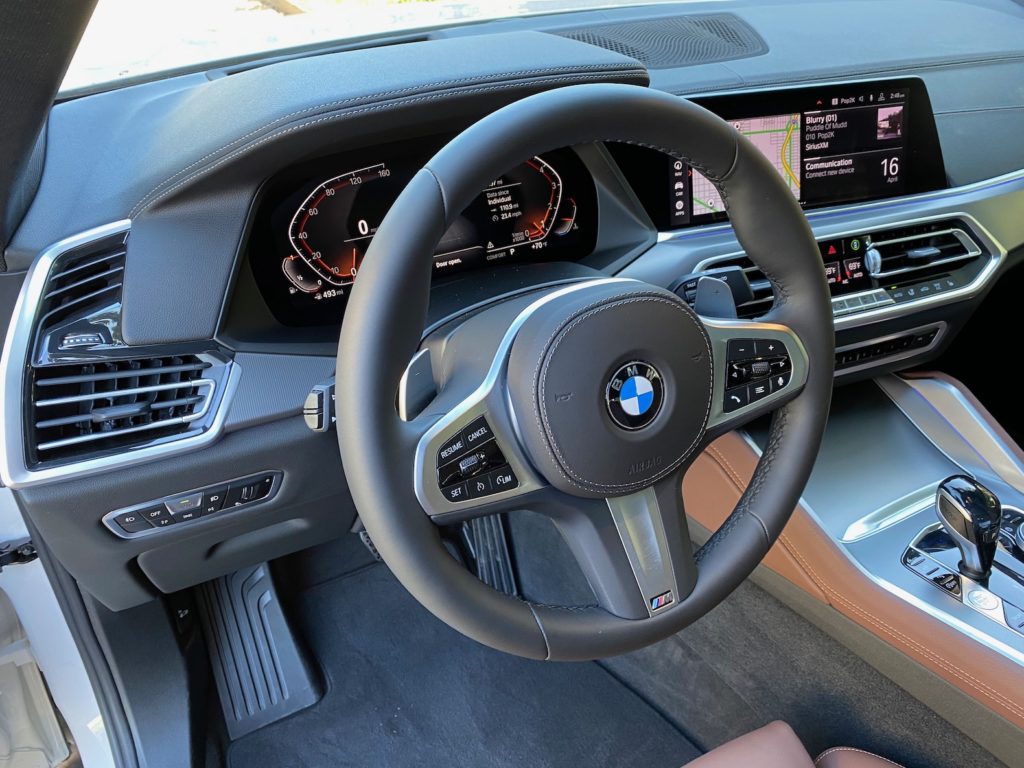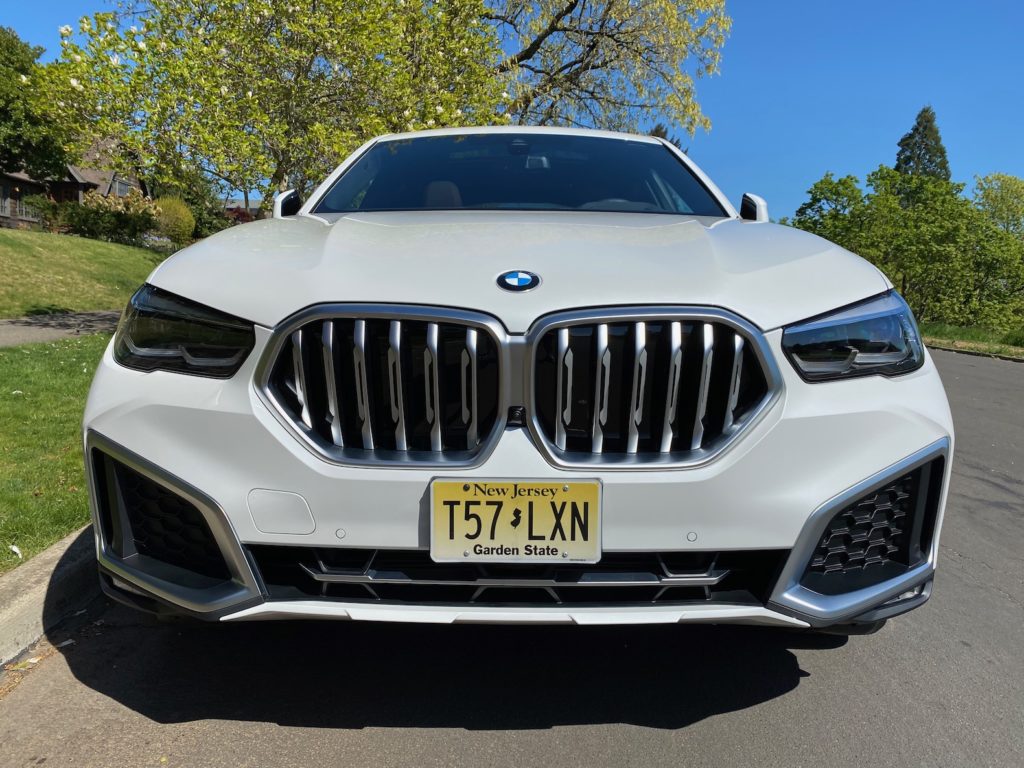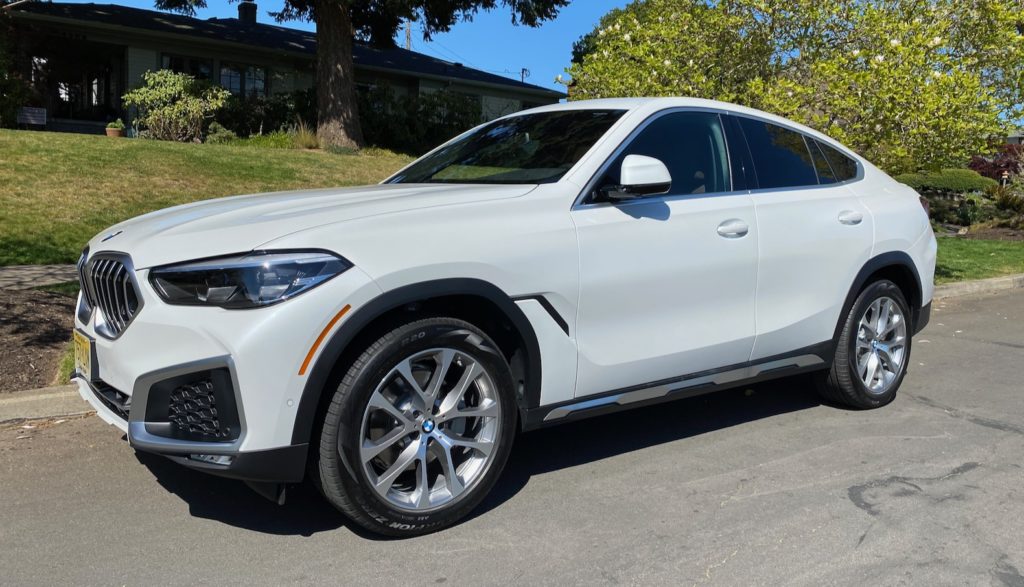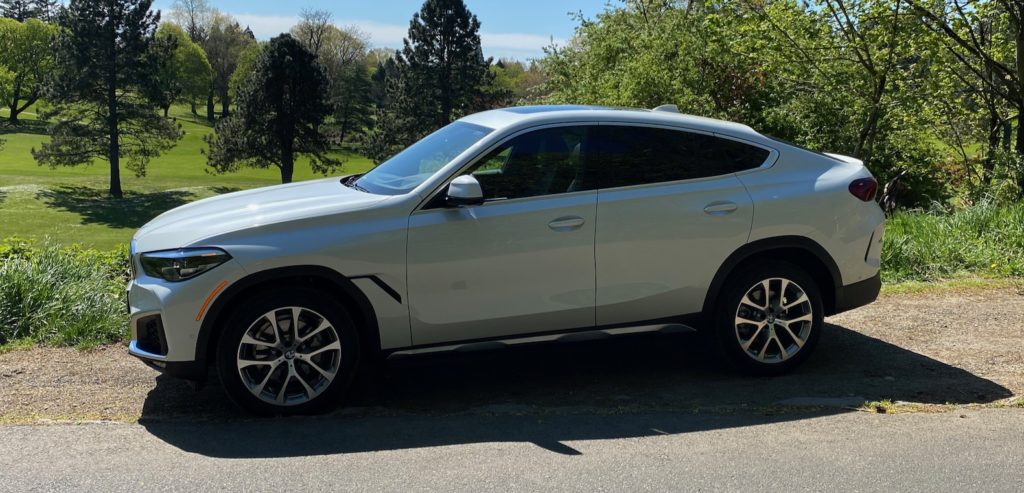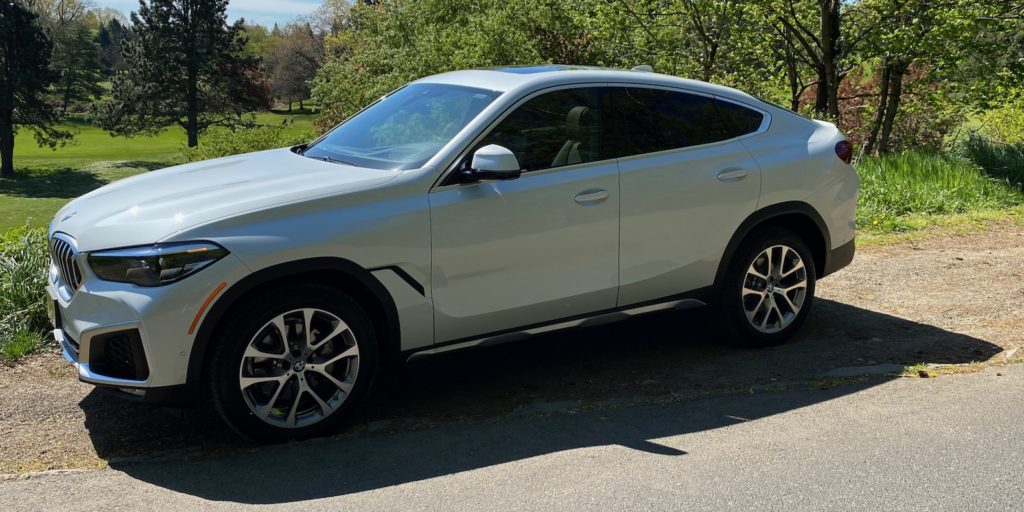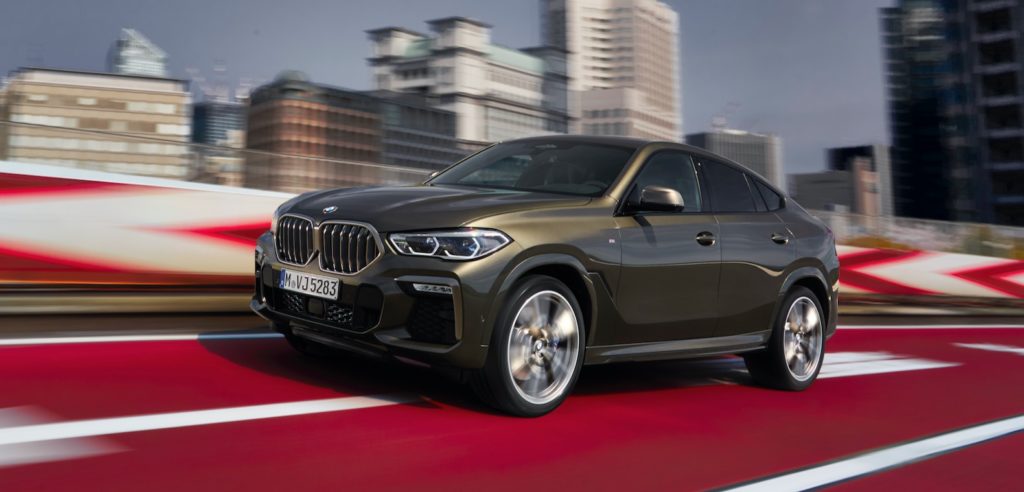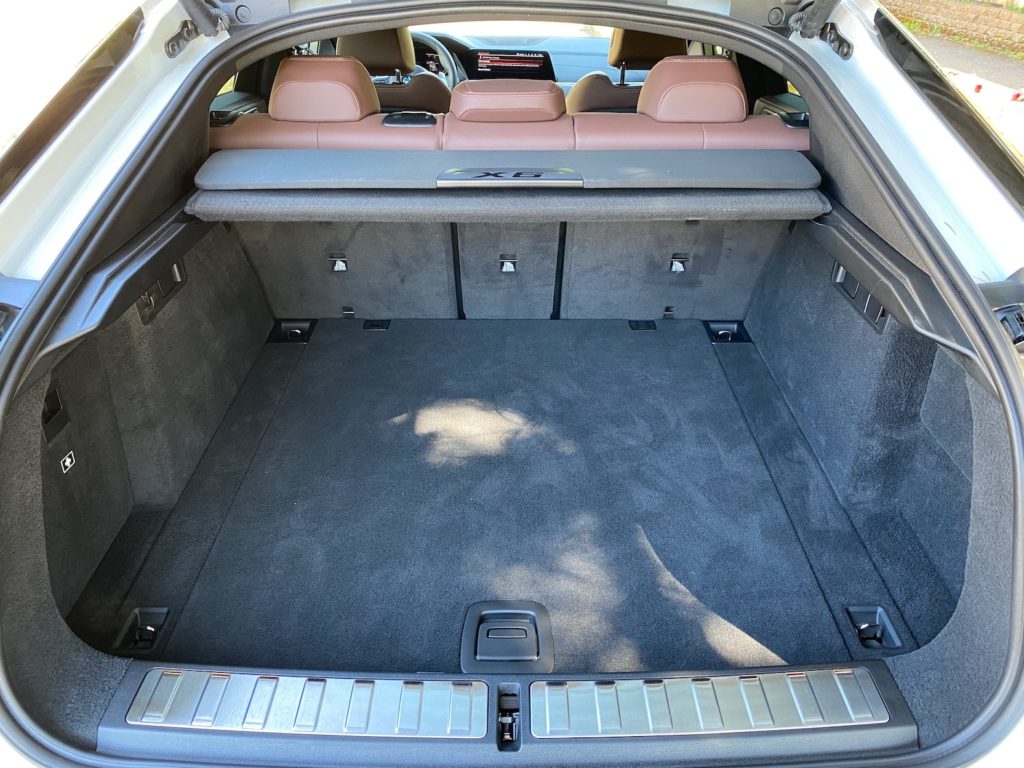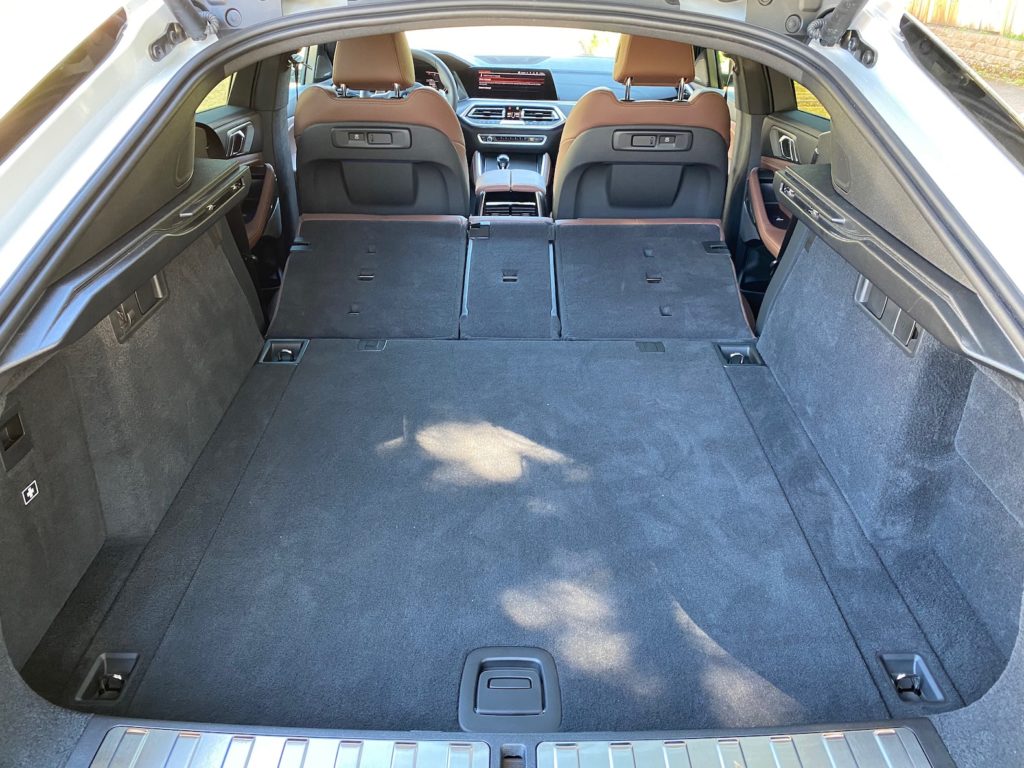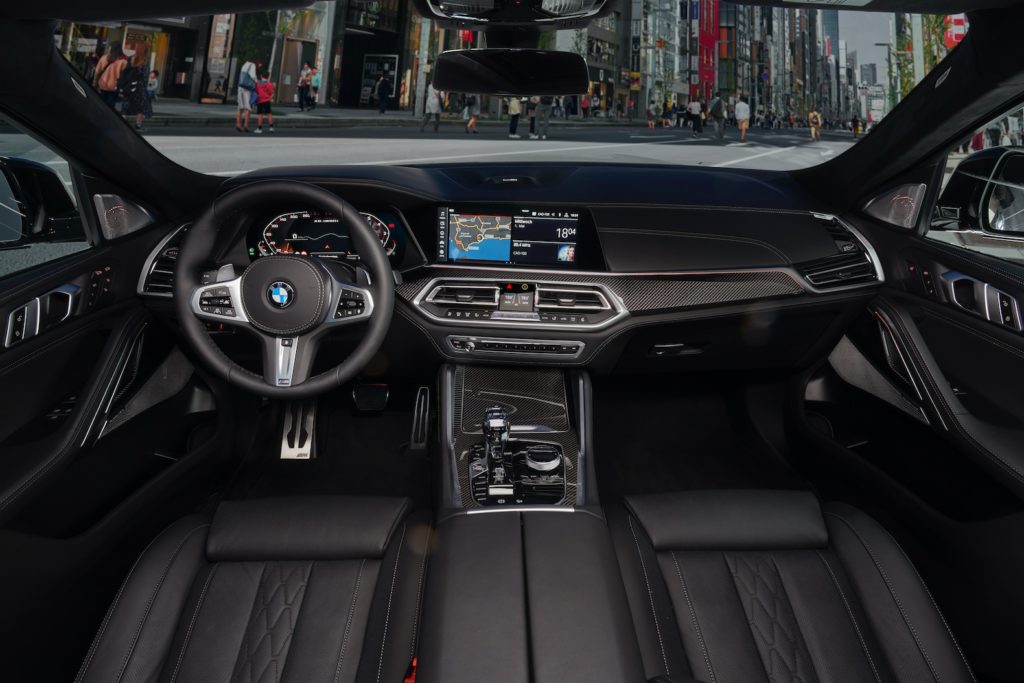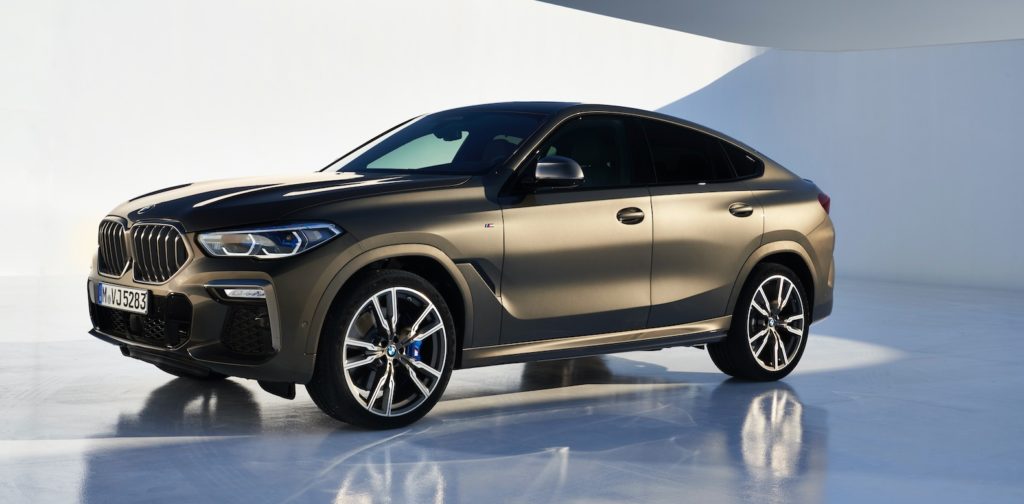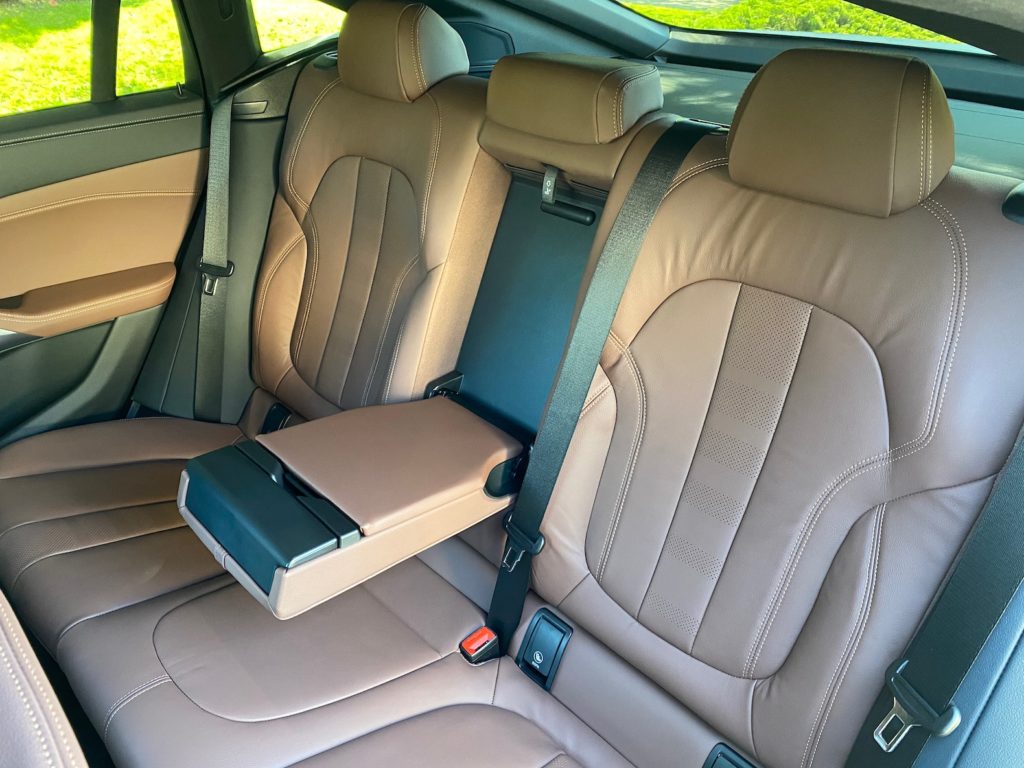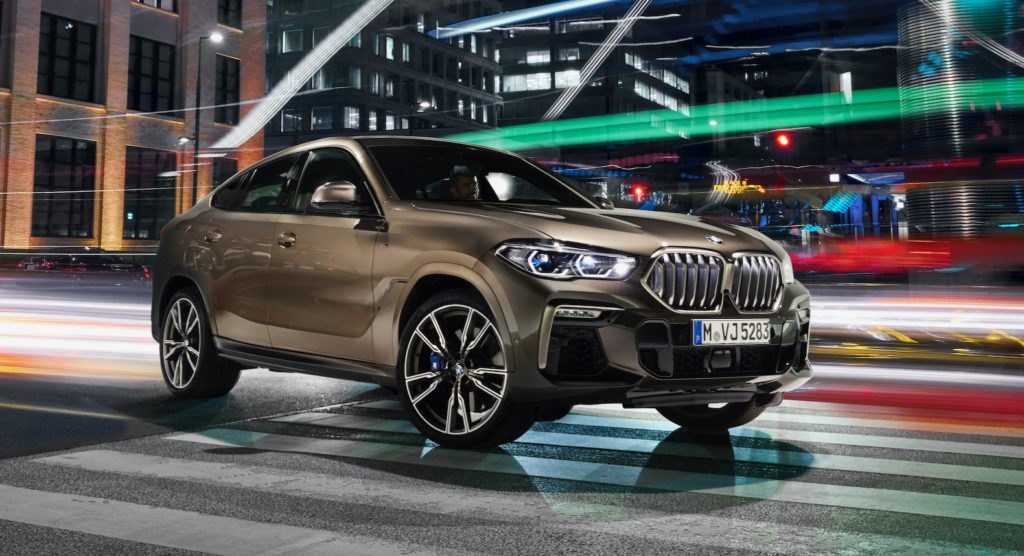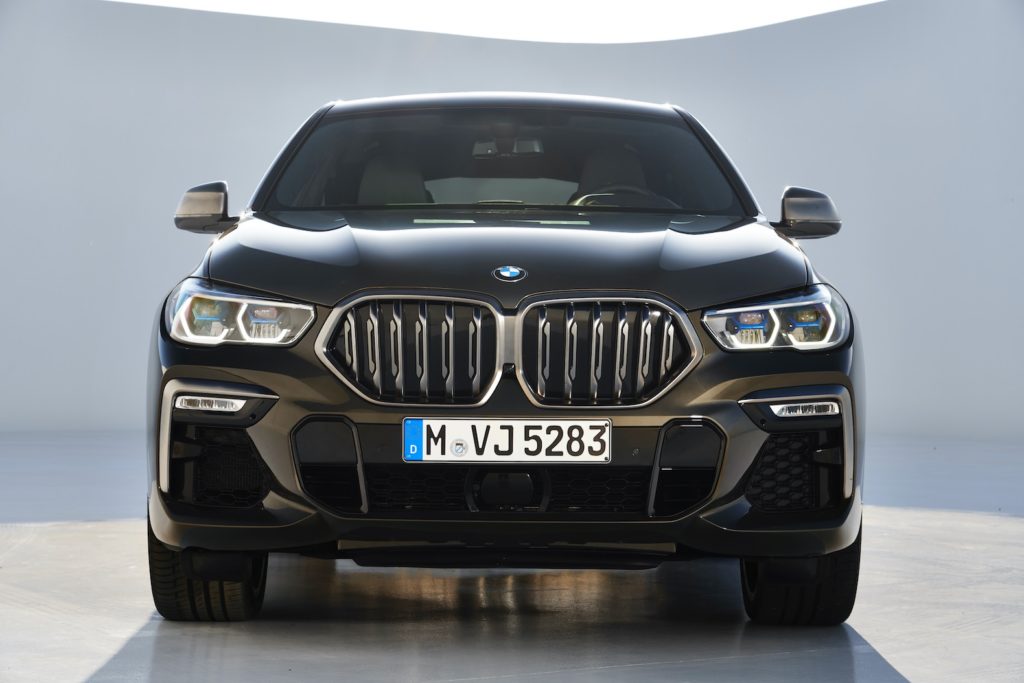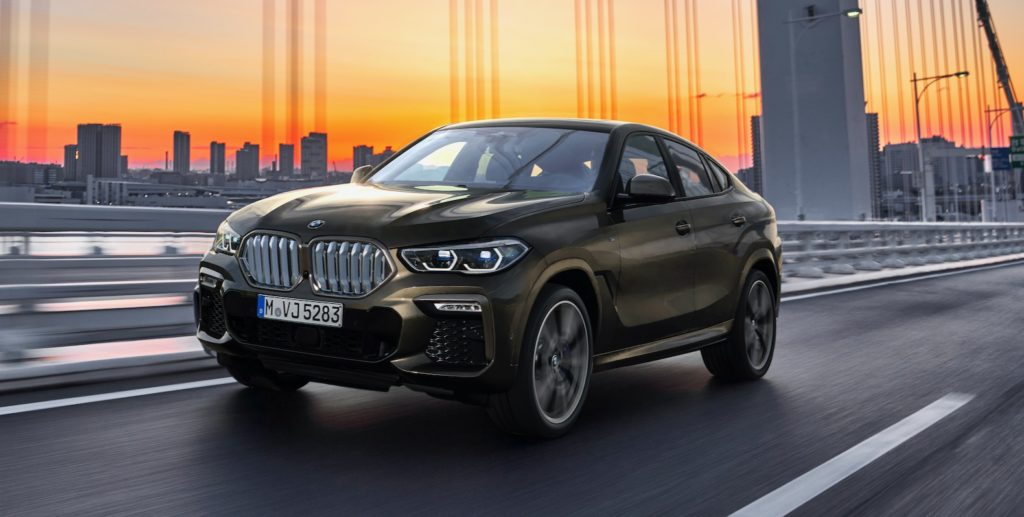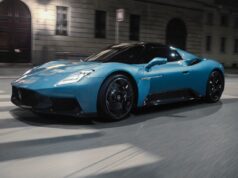The 2020 BMW X6 is the sleeker version of the X5. With the X6, BMW crossover coupe’s always been ahead of the styling curve by defying both convention and practicality. Now, in a market awash with coupe-overs, a market that BMW created, the X6 still takes the lead. The redesigned 2020 BMW X6 looks sharper, is more powerful and more efficient, and comes loaded with more standard features. The five-seat SUV sports the automaker’s big grille from its other models, including an optional light-up grille this time, that fronts the curvaceous four-door crossover with a bevy of tech inside. It’s longer and lower than the previous model, and that rounded turtle back looks more harmonious than the past two generations, but there’s nothing turtle-like about the way it drives.
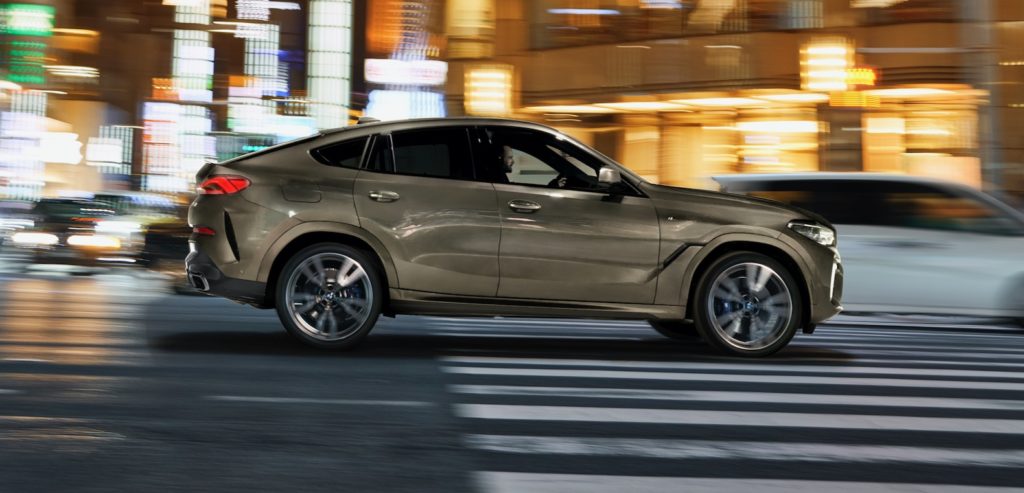
The third-generation X6 is available in rear-drive sDrive40i, all-wheel-drive xDrive40i as was our test vehicle, and V-8-powered M50i configurations, and starts at $65,295. The 617-horsepower X6 M Competition represents the performance peak for the line and starts just under $120,000. An 8-speed automatic transmission drives the X6, which uses the latest iteration of the 335-hp turbocharged inline-6 in the sDrive40i in rear-wheel drive or the xDrive40i in all-wheel drive. A new 523-hp twin-turbo V-8 engine powers the M50i, as well as the X6 M and M Competition models. All models benefit from significant boosts in horsepower, torque, and even fuel economy over the outgoing second-generation X6.
The latest iteration of the X6 looks more unified in the rear, and stands out more than the sea of other coupe-overs. The X6 is the cousin to the boxed end of the X5, which some would call a traditional crossover SUV. The X6 stands out from a market overrun by crossover SUVs. Since its launch for 2009, the rounded roofline of the X6 has been a love-it-or-hate-it proposition. It once looked like the top-half of a four-door coupe was melded onto the body of an SUV. It wasn’t a look for everyone, but it has definitely evolved. Now that nearly every luxury automaker has a coupe-over, the third-generation 2020 X6 appears much more unified and refined, easily beating others in the looks department.
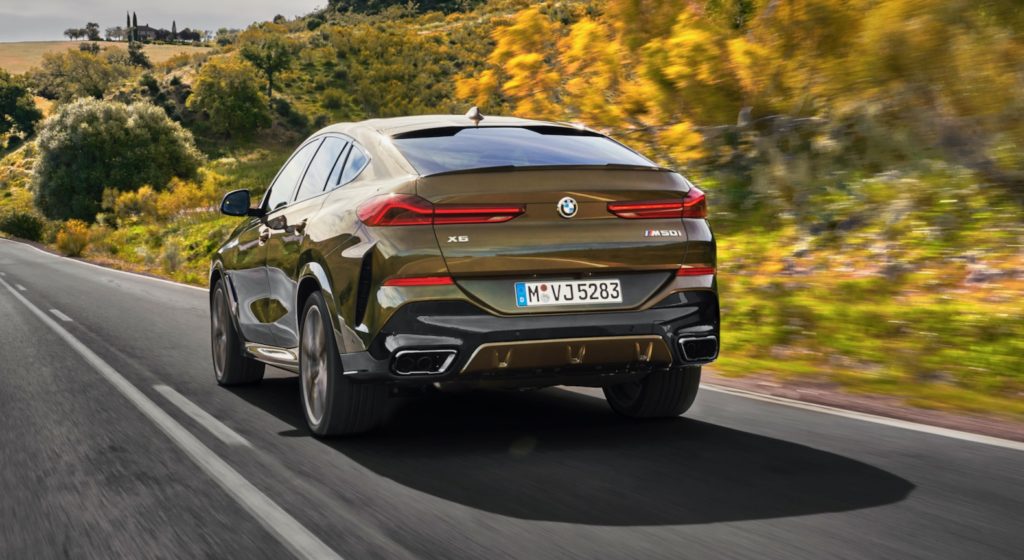
The 2020 X6 is longer, lower, and wider than before, with a sharper nose and a larger, bolder, kidney grille that is as in your face as diamond-studded teeth. That grille lights up now, too, in an almost Bavarian blue accent when so equipped. The body sides don’t deviate far from the X6’s formula: the descending roofline meets a small kickup in the windows toward the rear deck. Along the bottom of the doors, a sharper crease lowers the car’s visual weight and frames the wide and tall 20-inch wheels that are standard on all versions. The rear skirts in the rear fenders are cosmetic. Around back, the X6’s curviness changes to horizontal shelves with the decklid spoiler, rear taillights, and bottom liftgate, which all make distinct horizontal lines. The quad-tipped exhausts feature prominently at the rear end
The X6 is the more performance-minded midsize crossover from the brand known for performance. There’s a lot to like about the X6, and most of that comes from behind the wheel. There are five models based on two engines choices tuned to four different moods, and with a range of costs. BMW’s X6 starts off with the sDrive40i powered by a 335-horsepower 3.0-liter turbocharged inline-6 to drive the rear wheels. Mated to an 8-speed automatic on all X6s and most other BMWs, it generates 330 pound-feet of torque as early as 1,500 rpm. The new turbo-6 makes 33 hp more and 35 lb-ft more torque compared to the outgoing turbo-6. Getting it in all-wheel drive BMW calls the xDrive40i, which was our test vehicle. BMW says both models will accelerate from 0 to 60 mph in about five seconds; xDrive40i takes just 0.1-second longer because it’s heavier by about 200 pounds.
The M50i comes standard with all-wheel drive and comes with the new 523-hp version of the 4.4-liter twin-turbo V-8 found in the X6 M. Mechanically the same as the X5 M50i, the X6 uses a new engine that generates 78 hp and 74 lb-ft of torque more than the outgoing model. It propels the X6 M50i from 0 to 60 mph in 4.1 seconds, half a second faster than the 2019 model. It can take your breath away or, at the least, kickstart an ear-to-ear grin. With the 8-speed, it makes 553 lb-ft of torque from 1,800 to 4,600 rpm. The twin turbochargers ensure there’s no lag, and the V-8 provides a soundtrack that is tuned for refinement. The 8-speed automatic is quick but smooth, and limits the temptation to use the paddle shifters. The steering can feel light while cruising, but provides more feedback the more the wheel is turned.
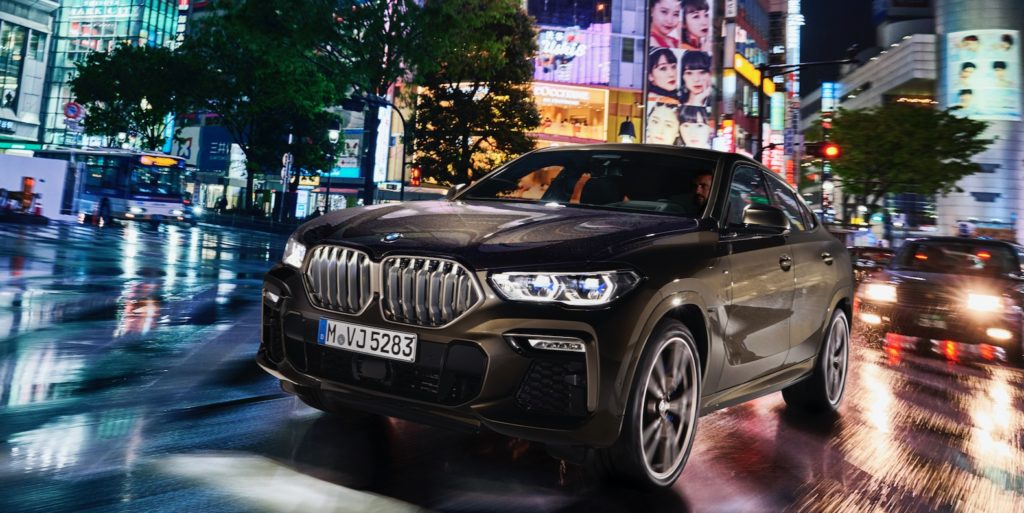
Then there are the X6 M and M Competition models. Let your jaw and stomach drop in equal proportion. The M uses a retuned version of the twin-turbo V-8 in the M50i to make 600 hp and 553 lb-ft from 1,800 to 5,690 rpm, which represents a 33-hp increase over the old X6 M. It hits 60 mph in 3.8 seconds, according to BMW. That’s stunning for a mid-size crossover, but then BMW out-BMW’s itself with the X6 M Competition, which makes 617 hp and hits 60 mph in 3.7 seconds. The structural changes to the 2020 X6 including a lower ride height and lower center of gravity make the X6 a little lighter on its heavy feet, but it is a crossover, no matter how much magic BMW puts into the suspension with the available Active Roll Stabilization. All X6 models use adaptive dampers to vary the stiffness of the suspension, although some models can be equipped with an air suspension that will raise or lower the car by 3 inches for more ground clearance for better road-holding. This year, the X6 can be equipped with rear-axle steering that can virtually shorten the wheelbase of the car or carve a tighter line through corners, or an off-road package that adds underbody protection and an electronically controlled rear differential.
Though much improved, fuel economy in the 2020 BMW X6 is second to power. Of all the improvements over the outgoing second generation, fuel economy may be the most remote when considering the potent powertrains. The 2020 BMW X6 is at least 2 mpg more efficient in the EPA’s combined rating in the higher volume models. The 2020 BMW X6 sDrive40i rates at 21 mpg city, 26 highway, 23 combined, according to the EPA. Adding all-wheel drive doesn’t lose much efficiency, with the xDrive40i version rated at 20/26/22 mpg. While the X6 M and X6 M Competition models ring in at 13/18/15 mpg, the more modestly turned twin-turbo V-8 in the M50i gives a best-case scenario: 16/22/18 mpg. All X6 crossovers require premium fuel. In our week with the xDrive40i we actually average slightly better than the combined EPA rating, ringing in at 24.3 mpg for the week.
The 2020 BMW X6 has not and probably will not be crash-tested by the government agencies, but it’s loaded with active safety tech. The IIHS and the NHTSA haven’t crashed the X6 in the name of safety, but the X5, which shares a platform and similarly sized to the X6, earned top ratings from both agencies. Every X6 is equipped with automatic emergency braking, blind-spot monitors, parking sensors, lane-departure warnings, high-beam assist, and adaptive LED headlights of the kind the IIHS usually requires for Top Safety Pick+ awards, like the one bestowed on the X5. Optional safety extras include active driving assistants with adaptive cruise control, active lane control, and lane change assist. A surround-view camera system is optional and a parking helper that remembers how drivers maneuver into a parking space is available, too. There’s plenty of gear to stay safe.
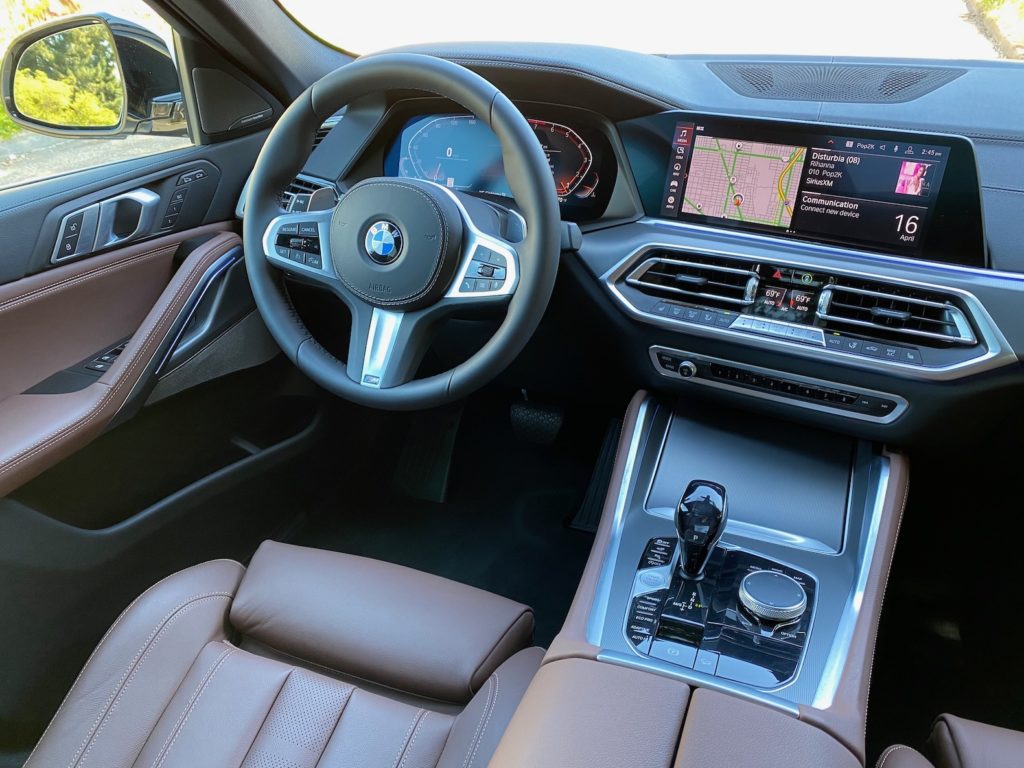
Longer, wider, lower, the 2020 X6 is only marginally roomier inside. The 2020 X6 is 1 inch longer than the model it replaces, including 1.6 inches added between the wheels. It’s fractionally wider and lower too, reportedly for better aerodynamics in the big, heavy crossover. The standard 16-way power front seats have more leg room than the outgoing model but slightly less head room. With the standard panoramic moonroof, even the tallest drivers would have a tough time noticing the reduction in head room. The standard sport buckets are firm and bolstered without being too rigid, providing a nice balance of support and comfort.
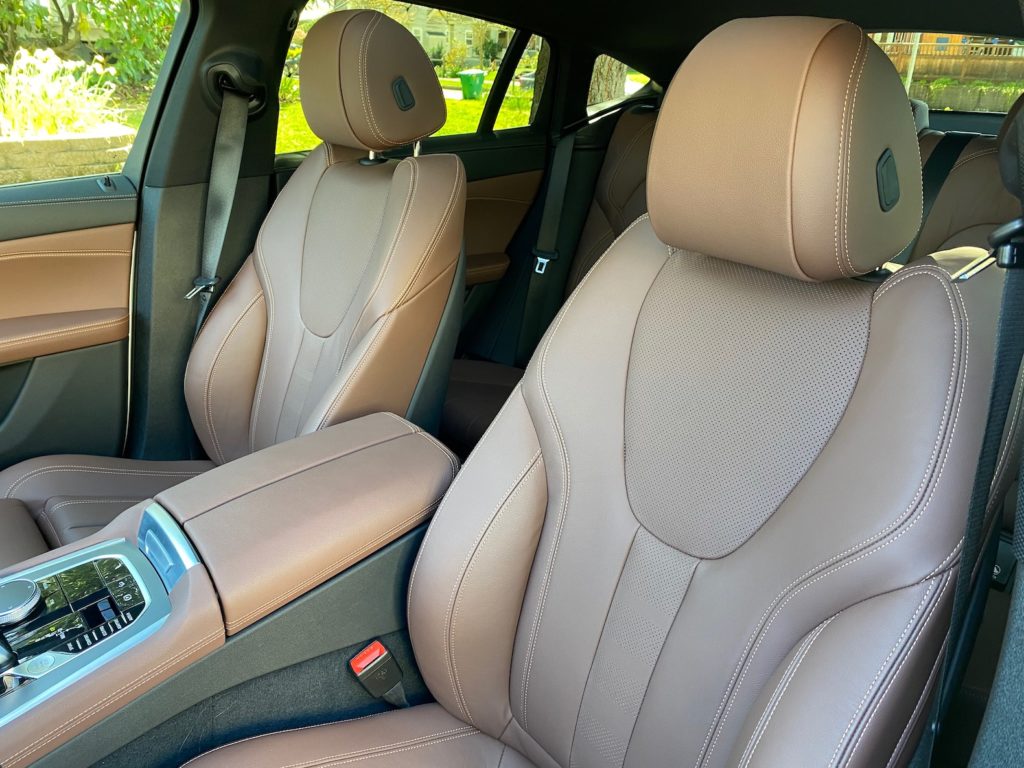
Rear-seat passengers get 35.7 inches of leg room, up incrementally over the outgoing version like the fronts, but even less head room than before, too. The turtleback of the X6 pinches rear vision, but at least the driver shouldn’t have to look past the bowed heads of rear-seat passengers with the great camera system. Cargo room is up slightly this year; 27.6 cubic feet with the seats up, 59.6 cubes with the second row folded in 40:20:40 configuration. The X6 isn’t as practical as the X5 from which it’s based that has 72.3 cubic feet of cargo room with the seats down, but X6 buyers seem to be after style more than practicality.
A horizontal motif carries over in the X6, same is in the related X5 and X7 crossovers. A wide 12.3-inch touchscreen for infotainment headlines the dash, and on the same top line is a 12.3-inch digital instrument cluster, although it’s not the “wall of screens” found in rivals from Mercedes-Benz, which is a good thing. The horizontally stretched layout feels as if the dash is reaching out in the key places where you need to make contact, such as the steering wheel and touchscreen, then retreating in the corners. The dash is covered in soft-touch synthetic leather, and leather hides cover the supportive sport bucket seats.
The touchscreen is part of the iDrive 7.0 infotainment system. It’s dense with options but relatively easy to use once you take the time to learn the language. Natural voice controls abet the simplicity, and eventually make it the only thing you need to use to sort through the most vital features. The speedo and tachometer wrap around the digital instrument cluster, which can be off-putting at first, but is a pretty economical way to open the interior real estate. The map display in the center is like a beta version of Audi’s superior Virtual Cockpit, but it’s still a nice improvement over iDrive 6.0. The best features are the twin torque and horsepower gauges on the right side of the cluster. Bring an adapter if you want to charge your phone because it’s USB-C or bust for the X6.
The base model comes well-equipped with standard active safety features, the latest iDrive 7.0 infotainment system with a 12.3-inch touchscreen and 12.3-inch digital instrument cluster, leather upholstery, heated front seats, ambient lighting, and other optional goodies that range from the practical to the preposterous, and we’re not just talking gesture control.
Improved infotainment and more standard features define the X6. Starting at $65,295 (including $995 destination) and ranging to nearly $120,000 with the X6 M Competition, the 2020 BMW X6 comes well-equipped. The X6 M50i offers the best blend of value and performance. All X6s are equipped with 20-inch wheels, leather upholstery, panoramic moonroof, a 12.3-inch touchscreen for infotainment with Apple CarPlay compatibility (Android Auto coming in mid-2020), heated front seats, a 12.3-inch digital instrument cluster, ambient lighting the kids love, parking sensors, a USB-C port, Bluetooth connectivity, automatic emergency braking, blind-spot monitors, high-beam assist, and adaptive LED headlights.
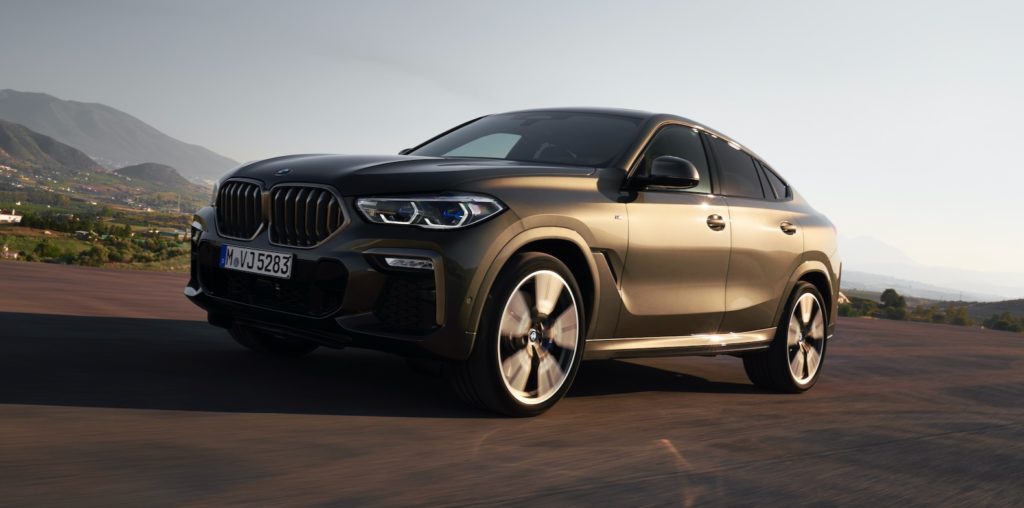
The options start with all-wheel drive, which adds $2,300 to the X6 sDrive40i. From there, the $86,545 M50i comes with standard all-wheel drive and upgrades to 20-way power front seats, Harmon Kardon 16-speaker system, a three-spoke leather-wrapped M steering wheel, and all the M suspension bits.
The X6 M for $109,595 features a 600-hp V-8 engine with the $118,595 Competition version getting a boost to 617 horsepower; both include standard heated front armrests. Even though the package options have been streamlined in recent years, BMW has plenty of places for you to spend more money. Softer leather upholstery, deeper sport buckets, driving assistants, a head-up display, 21- or 22-inch wheels, light-up grille, glass controls, wireless smartphone charging, cooled front seats, heated rear seats, premium audio, and a night-vision camera are all on the options list.
There’s even more that can take luxury to that next level. These include the Sky Lounge panoramic roof that has more than 15,000 illuminated points to simulate a night sky, like a Rolls-Royce headliner. There are heated and cooled cupholders, soft-close doors, massaging seats, and the illuminated kidney grille that can remain on night or day. More compelling available features include Laserlight headlights, which enable you to see twice as far down the road and are 10 times stronger than traditional LEDs, according to BMW. One other standard feature we can get behind is the 4-year/50,000-mile limited warranty including three years of complimentary scheduled maintenance.
The BMW X6 is a rare breed that started a whole new genre of sleek crossovers. With the all new X6 for 2020, BMW continues to refine the recipe that makes the X6 such a standout. With updated styling, impressive driving manners, efficient powertrains, and cutting edge technology it does everything well, very well. The first crossover coupe is still the best and the one to beat.
For all your new car shopping needs, check out: drivevise.com Vehicle shopping made simple!

